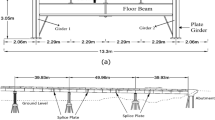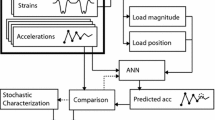Abstract
Detecting structural damage in civil engineering structures has become an increasingly viable option for efficient maintenance and management of infrastructures. Vibration-based damage detection methods have been widely used for structural health monitoring. However, those methods may not be effective when modal properties have significant variance under environmental effects, especially severe temperature changes. In this paper, an extended Kalman filter-based artificial neural network (EKFNN) method is developed to eliminate the temperature effects and detect damage for structures equipped with long-term monitoring systems. Based on the vibration acceleration and temperature data obtained from an in-service highway bridge located in Connecticut, United States, the correlations between natural frequencies and temperature are analyzed to select proper input variables for the neural network model. Weights of the neural network are estimated by extended Kalman filter, which is also used to derive the confidence intervals of the natural frequencies to detect the damage. A year-long monitoring data are fed into the developed neural network for the training purpose. To assess the changes of natural frequencies in real structural damages, structural damage scenarios are simulated in the finite element model. Numerical testing results show that the temperature-induced changes in natural frequencies have been considered prior to the establishment of the threshold in the damage warning system, and the simulated damages have been successfully captured. The advantages of EKFNN method are presented through comparing with benchmark multiple linear regressions method, showing the potential of this method for structural health monitoring of highway bridge structures.





















Similar content being viewed by others
References
Doebling SW, Farrar CR, Prime MB (1998) A summary review of vibration-based damage identification methods. Shock Vibr Dig 30(2):91–105
Sohn H, Farrar CR, Hemez FMA et al (2004) A review of structural health monitoring literature: 1996–2001. Rep. No. LA-13976-MS. Los Alamos National Laboratory, Los Alamos
Yan YJ, Cheng L, Wu ZY et al (2007) Development in vibration-based structural damage detection technique. Mech Syst Signal Process 21:2198–2211
Cornwell P, Farrar CR, Doebling SW et al (1999) Environmental variability of modal properties. Exp Tech 23(6):45–48
Peeters B, Roeck GD (2001) One-year monitoring of the Z24-Bridge: environmental effects versus damage events. Earthq Eng Struct Dyn 30:149–171
Xia Y, Chen B, Weng S et al (2012) Temperature effect on vibration properties of civil structures: a literature review and case studies. J Civil Struct Health Monit 2(1):29–46
Liu C, DeWolf JT (2007) Effect of temperature on modal variability of a curved concrete bridge under ambient loads. J Struct Eng 133(12):1742–1751
Sohn H (2007) Effects of environmental and operational variability on structural health monitoring. Philos Trans R Soc A Math Phys Eng Sci 365:539–560
Soyoz S, Feng MQ (2009) Long-term monitoring and identification of bridge structural parameters. Comput Aided Civil Infrastruct Eng 24:82–92
Cao Y, Yim J, Zhao Y et al (2011) Temperature effects on cable stayed bridge using health monitoring system: a case study. Struct Health Monit 10(5):523–537
Ding Y, Li A (2011) Temperature-induced variation of measured modal frequencies of steel box girder for a long-span suspension bridge. Int J Steel Struct 11(2):145–155
Cross EJ, Koo KY, Brownjohn JM et al (2013) Long-term monitoring and data analysis of the Tamar Bridge. Mech Syst Signal Process 35:16–34
Jin C, Li J, Jang S et al (2015) Structural damage detection for in-service highway bridge under operational and environmental variability. In: SPIE Smart Structures NDE, San Diego, California, USA, 8–12 March 2015, paper no. 94353A, International Society for Optics and Photonics
Gonzales I, Ülker-Kaustell M, Karoumi R (2013) Seasonal effects on the stiffness properties of a ballasted railway bridge. Eng Struct 57:63–72
Li J (2014) Structural health monitoring of an in-service highway bridge with uncertainties. PhD Thesis, University of Connecticut, USA
Peeters B, Maeck J, Roeck GD (2001) Vibration-based damage detection in civil engineering: excitation sources and temperature effects. Smart Mater Struct 10:518–527
Sohn H, Worden K, Farrar CR (2002) Statistical damage classification under changing environmental and operational conditions. J Intell Mater Syst Struct 13:561–574
Zhou HF, Ni YQ, Ko JM (2010) Constructing input to neural networks for modeling temperature-caused modal variability: mean temperatures, effective temperatures, and principal components of temperatures. Eng Struct 32(6):1747–1759
Zhou HF, Ni YQ, Ko JM (2011) Eliminating temperature effect in vibration-based structural damage detection. J Eng Mech 137:785–796
Xu H, Humar J (2006) Damage detection in a girder bridge by artificial neural network technique. Comput Aided Civil and Infrastruct Eng 21(6):450–464
Mata J (2011) Interpretation of concrete dam behaviour with artificial neural network and multiple linear regression models. Eng Struct 33(3):903–910
Christenson R, Bakulski SK, McDonnell AH (2011) Establishment of a dual-purpose bridge health monitoring and weigh-in-motion system for a steel girder bridge. In: Transportation Research Board 90th Annual Meeting, Washington, D.C., USA, 23–27 January 2011, paper no. 11-1598
Bagchi A, Humar J, Xu H et al (2010) Model-based damage identification in a continuous bridge using vibration data. J Perform Constr Facil 24(2):148–158
Plude S (2011) Implementing a long-term bridge monitoring strategy for a composite steel girder bridge. Master Thesis, University of Connecticut, USA
Samali B, Li J, Crews KI et al (2007) Load rating of impaired bridges using a dynamic method. Electron J Struct Eng 7:66–75
Karoumi R, Andersson A, Sundquist H (2006) Static and dynamic load testing of the New Svinesund Arch Bridge. In: The international conference on bridge engineering—challenges in the 21st century, 1–3 November 2006, Hong Kong
Gutierrez-Osuna R. Intelligent sensor systems Lecture 13. http://research.cs.tamu.edu/prism/lectures/iss/iss_l13.pdf. Accessed 14 June 2015
Shumway RH, Stoffer DS (2013) Time series analysis and its applications. Springer Science & Business Media
Antoniadis A, Paparoditis E, Sapatinas T (2006) A functional wavelet-kernel approach for time series prediction. J R Stat Soc B 68:837–857
Author information
Authors and Affiliations
Corresponding author
Rights and permissions
About this article
Cite this article
Jin, C., Jang, S., Sun, X. et al. Damage detection of a highway bridge under severe temperature changes using extended Kalman filter trained neural network. J Civil Struct Health Monit 6, 545–560 (2016). https://doi.org/10.1007/s13349-016-0173-8
Received:
Revised:
Accepted:
Published:
Issue Date:
DOI: https://doi.org/10.1007/s13349-016-0173-8




